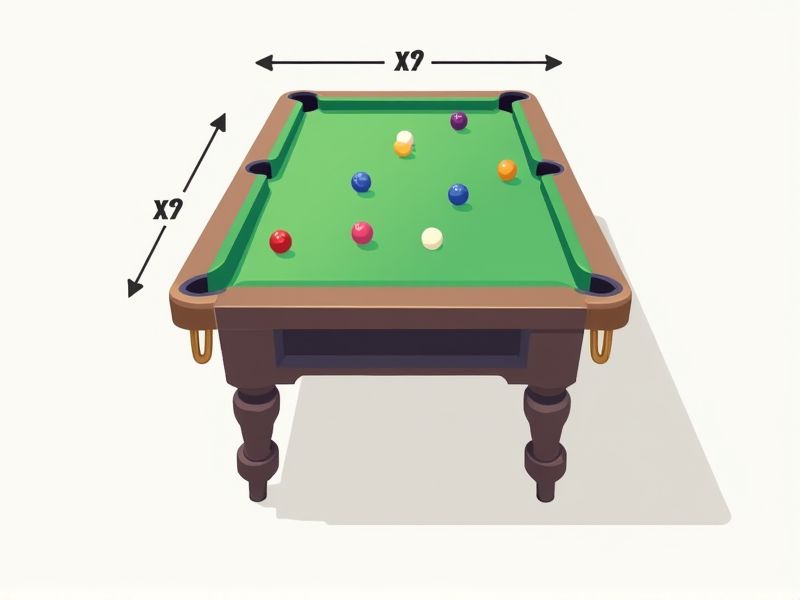
The standard dimensions of a billiards table can vary depending on the game being played, but the most common size for professional pool tables is 9 feet long by 4.5 feet wide (2.74 meters by 1.37 meters). For home or recreational use, 7-foot (2.13 meters by 1.07 meters) and 8-foot (2.44 meters by 1.22 meters) tables are also popular choices. Make sure to allow for enough space around the table--ideally at least 5 feet (1.5 meters) on all sides--to ensure players have plenty of room to maneuver their cues. Considering these dimensions can help you plan the best layout for your billiards space and avoid any playing restrictions.
Play Surface Dimensions
The standard billiards table features a play surface dimension of 88 inches by 44 inches for American pool, while a snooker table typically measures 12 feet by 6 feet. Maintaining these dimensions is crucial for optimal gameplay and ensures consistency across tournaments and casual games alike. The height of the table is generally around 29.5 inches, allowing players of varying heights to comfortably engage in matches. Ensuring your table conforms to these specifications will enhance your playing experience and accuracy in shots.
Cushion Thickness
The standard thickness of billiards table cushions is typically between 1.5 to 2 inches, ensuring proper rebound and playability. High-quality tables often utilize rubber compounds, like natural rubber, to enhance durability and performance, which can dramatically impact shot accuracy. A well-constructed cushion can maintain its shape over time, offering consistent response throughout extensive use. You can measure the cushion thickness yourself to ensure it meets competitive standards, optimizing your gameplay experience.
Pocket Apertures
Pocket apertures on a standard billiards table measure approximately 4.5 inches in width for American pool, allowing for a balance between challenge and skill. In contrast, a British snooker table features smaller pocket sizes of about 3.5 inches, demanding greater precision and control from players. The design of these pockets directly affects gameplay dynamics, with wider pockets facilitating faster-paced games while narrower ones emphasize strategic play. Understanding the specifications of pocket apertures can significantly enhance your competitive edge and overall enjoyment of the game.
Rail Width
The standard rail width for a billiards table is typically between 4 to 5 inches, a measurement crucial for gameplay and consistency. This dimension affects ball rebound and control, with a wider rail allowing for increased ball interaction. You should consider that the surface material also plays a significant role, as more resilient fabrics can enhance durability and affect play dynamics. Ensuring your table adheres to these standard measurements can significantly enhance your overall billiards experience.
Table Height
The standard height of a billiards table is typically 29.5 inches (75 cm) from the floor to the playing surface. This measurement ensures optimal playability and comfort for a wide range of players. When selecting a billiards table, maintaining this standard height allows for a balanced stance and proper cueing technique. Investing in a table that adheres to these dimensions can significantly enhance your playing experience and skill development.
Slate Thickness
The standard thickness for slate used in billiards tables typically ranges from 1 inch (25.4 mm) to 1.5 inches (38.1 mm), with 1-inch slate being the most common in pool tables. A thicker slate, such as 1.5 inches, can provide increased stability and a smoother playing surface, essential for competitive play. High-quality slate ensures durability and resistance to warping, which can affect the quality of gameplay over time. When selecting a billiards table, consider the slate thickness as a critical factor to enhance your playing experience and accuracy.
Leg Position
The standard billiards table typically measures 9 feet by 4.5 feet, requiring players to adopt specific leg positions for optimal stability and balance while shooting. Proper stance involves placing your feet shoulder-width apart, with one foot slightly forward to maintain a stable base. This leg positioning allows for effective weight distribution and minimizes unnecessary movement during your shot. By refining your stance, you can improve your accuracy and control, significantly enhancing your overall performance at the table.
Playing Cloth Size
The playing cloth size of a standard billiards table is typically 9 feet by 4.5 feet for American pool, while snooker tables measure 12 feet by 6 feet. High-quality cloth, such as worsted wool, is preferred for its durability and smoother gameplay, reducing friction during ball movement. Regular maintenance, including cleaning and replacement of worn cloth, ensures optimum performance and an enhanced playing experience. You can expect to see a range of cloth options, with prices varying widely from around $30 to over $100 per yard, depending on the quality and brand.
Room Space Requirements
The standard room space requirement for a billiards table is crucial for optimal playability and comfort. For a 7-foot billiards table, a room size of at least 13 feet by 16 feet is recommended; for a 9-foot table, you should consider a minimum of 14 feet by 18 feet. This space allows for ample clearance around the table, accommodating the cue length of 58 inches while ensuring players can move freely. Adequate lighting and ventilation are also essential within this space to enhance your playing experience.
Frame Strength
The frame strength of a billiards table is crucial for maintaining stability and ensuring a consistent playing surface. Typically constructed from high-quality hardwood, a standard billiards table frame must withstand the impact of fast-paced shots while resisting warping over time. Measurements for a standard table range from 7 to 9 feet in length, with the thickness of the frame often exceeding 1 inch to enhance durability. To assess frame strength effectively, look for tables with a weight of at least 800 pounds, as heavier tables tend to provide a more level and reliable playing experience.
